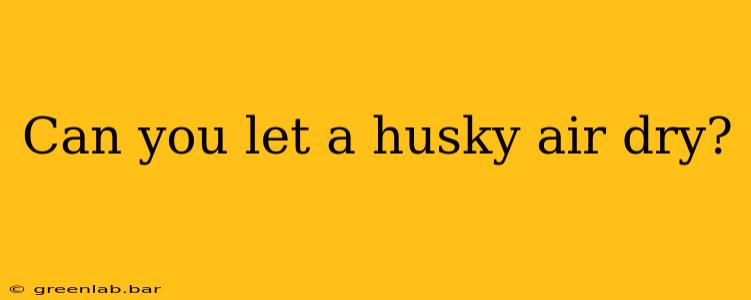Husky owners often wonder about the best way to dry their fluffy companions after a bath or a romp in the rain. While the image of a snowy husky shaking itself dry is charming, the reality of letting a husky air dry completely might not be as straightforward as it seems. This comprehensive guide will explore the pros and cons of air drying your husky and offer expert advice on how to best manage their thick double coat.
Understanding the Husky Double Coat
Before diving into the drying methods, it's crucial to understand the unique nature of a husky's coat. Huskies possess a dense double coat consisting of a soft, downy undercoat and a longer, coarser topcoat. This remarkable insulation keeps them warm in frigid temperatures but also makes drying a more complex process. The thick undercoat traps moisture, which can take a considerable amount of time to evaporate naturally.
The Pros and Cons of Air Drying a Husky
Pros:
- Reduced Stress: Air drying eliminates the potential stress associated with using a hairdryer or other drying methods, especially for anxious dogs.
- Natural Oil Preservation: Air drying helps maintain the natural oils in the husky's coat, contributing to a healthier, shinier coat. Harsh drying methods can strip these essential oils.
- Cost-Effective: Air drying is, of course, the most economical option.
Cons:
- Time-Consuming: The most significant drawback is the sheer time it takes for a husky's thick coat to air dry completely. This can range from several hours to a full day, depending on the weather and the dog's coat thickness.
- Potential for Hypothermia: In colder climates, or if the dog is left damp for extended periods, there's a risk of hypothermia, especially for puppies or older huskies.
- Unpleasant Odor: A damp husky coat can develop an unpleasant odor if not dried properly, creating a lingering smell in your home.
- Increased Risk of Matting: The long hair in the coat can mat more easily if left wet for extended periods.
Best Practices for Air Drying Your Husky
While fully air drying might not always be practical or safe, you can certainly utilize it as part of a drying strategy. Here's how:
1. Thorough Towel Drying:**
Begin by thoroughly towel-drying your husky after their bath. Use a large, absorbent towel and gently but firmly rub the coat to remove as much excess water as possible. Focus on the undercoat, as this is where the moisture tends to accumulate.
2. Controlled Air Drying:**
Choose a warm, well-ventilated area to let your husky air dry. Avoid drafts or cold temperatures. A sunny spot can be helpful, but avoid direct sunlight for extended periods to prevent overheating or sunburning.
3. Monitoring and Intervention:**
Closely monitor your husky's temperature and coat dryness. If the weather is cool or your husky seems cold, consider using a low-heat setting on a hairdryer (keeping it at a safe distance) or gently towel drying again.
4. Brushing:**
Once the coat is mostly dry, brush your husky thoroughly to prevent matting and to distribute natural oils.
When Air Drying Isn't Enough: Alternative Methods
In certain situations, relying solely on air drying might not be sufficient. Here are some alternatives:
- Low-Heat Hair Dryer: Use a hairdryer on a low, cool setting, keeping it at a safe distance to avoid burning your dog's skin. Focus on the undercoat, using a technique similar to blow-drying your own hair.
- Dog-Specific Drying Towels: These microfiber towels are highly absorbent and can significantly reduce drying time.
Conclusion: A Balanced Approach
Air drying your husky can be a part of a healthy grooming routine, especially during warmer months. However, it's essential to weigh the pros and cons and adapt your approach based on your husky's individual needs, the weather conditions, and your available time. A balanced approach that combines towel drying with controlled air drying, and perhaps occasional use of a hairdryer, will generally ensure a comfortable and healthy experience for your furry friend. Always prioritize your husky's comfort and well-being, and don't hesitate to consult your veterinarian if you have any concerns about their coat health or drying methods.

